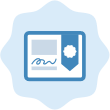R Programming
Part of the Data Science Specialization »
Learn how to program in R and how to use R for effective data analysis. This is the second course in the Johns Hopkins Data Science Specialization.
In this course you will learn how to program in R and how to use R for effective data analysis. You will learn how to install and configure software necessary for a statistical programming environment and describe generic programming language concepts as they are implemented in a high-level statistical language. The course covers practical issues in statistical computing which includes programming in R, reading data into R, accessing R packages, writing R functions, debugging, profiling R code, and organizing and commenting R code. Topics in statistical data analysis will provide working examples.
Please note: we are offering a Chinese version of this course starting March 2, re-running on a monthly basis and sharing the same schedule with the English version. If you are interested, please select from the drop-down list sessions marked as "(中文版)".
Please note: we are offering a Chinese version of this course starting March 2, re-running on a monthly basis and sharing the same schedule with the English version. If you are interested, please select from the drop-down list sessions marked as "(中文版)".
Course Syllabus
The course will cover the following material each week:
- Week 1: Overview of R, R data types and objects, reading and writing data
- Week 2: Control structures, functions, scoping rules, dates and times
- Week 3: Loop functions, debugging tools
- Week 4: Simulation, code profiling
Recommended Background
Some familiarity with programming concepts will be useful as well basic knowledge of statistical reasoning; Data Scientist's Toolbox
Suggested Readings
The e-book R Programming for Data Science covers all of the material presented in this course. It is available for download from Leanpub.
Course Format
There will be weekly lecture videos, quizzes, and programming assignments.
As part of this class you will be required to set up a GitHub account. GitHub is a tool for collaborative code sharing and editing. During this course and other courses in the Specialization you will be submitting links to files you publicly place in your GitHub account as part of peer evaluation. If you are concerned about preserving your anonymity you will need to set up an anonymous GitHub account and be careful not to include any information you do not want made available to peer evaluators.
FAQ
How do the courses in the Data Science Specialization depend on each other?
We have created a handy course dependency chart to help you see how the nine courses in the specialization depend on each other.
Will I get a Statement of Accomplishment after completing this class?Free statements of accomplishment are not offered in this course. If you are not enrolled in Signature Track, participation and performance documentation will be reported on your Accomplishments page, but you will not receive a signed statement of accomplishment.
What resources will I need for this class?
A computer is needed on which the R software environment can be installed (recent Mac, Windows, or Linux computers are sufficient).
How does this course fit into the Data Science Specialization?
This is the second course in the sequence. We strongly recommend that you take The Data Scientist's Toolbox before taking R Programming.
Russian subtitles for this course are courtesy of IBS.
We have created a handy course dependency chart to help you see how the nine courses in the specialization depend on each other.
Will I get a Statement of Accomplishment after completing this class?Free statements of accomplishment are not offered in this course. If you are not enrolled in Signature Track, participation and performance documentation will be reported on your Accomplishments page, but you will not receive a signed statement of accomplishment.
What resources will I need for this class?
A computer is needed on which the R software environment can be installed (recent Mac, Windows, or Linux computers are sufficient).
How does this course fit into the Data Science Specialization?
This is the second course in the sequence. We strongly recommend that you take The Data Scientist's Toolbox before taking R Programming.
Russian subtitles for this course are courtesy of IBS.

















No comments:
Post a Comment